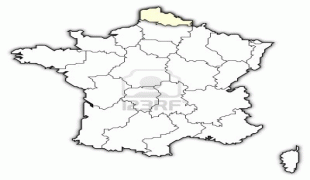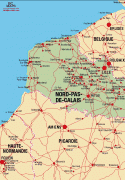Nord-Pas-de-Calais
 |
 |
With its 330.8 people per km2 on just over 12,414 km2, it is a densely populated region, having some 4.1 million inhabitants, 7% of France's total population, making it the fourth most populous region in the country, 83% of whom live in urban communities. Its administrative centre and largest city is Lille. The second largest city is Calais, which serves as a major continental economic/transportation hub with Dover of Great Britain 42 km away; this makes Nord-Pas-de-Calais the closest continental European connection to the island of Great Britain. Other major towns include Valenciennes, Lens, Douai, Béthune, Dunkirk, Maubeuge, Boulogne, Arras, Cambrai and Saint-Omer. The region is featured in numerous films, including Bienvenue chez les Ch'tis.
Nord-Pas-de-Calais combines the names of the constituent departments of Nord (literally 'North', the northernmost department of France) and Pas-de-Calais ('Strait of Calais', the French name of the Strait of Dover). The regional council, however, spells the name Nord-Pas de Calais.
The northern part of the region was historically a part of the County of Flanders, with Douai as its capital. Those who wish to evidence the historical links the region has with Belgium and the Netherlands prefer to call this region the French Low Countries, which also means French Netherlands in French (French: Pays-Bas français; Dutch: Franse Nederlanden or Franse Lage Landen). Other alternative names are Région Flandre(s)-Artois, Hauts-de-France, ('Upper France') and Picardie-du-Nord ('Northern Picardy').
Map - Nord-Pas-de-Calais
Map
Country - France
 |
 |
| Flag of France | |
Inhabited since the Palaeolithic era, the territory of Metropolitan France was settled by Celtic tribes known as Gauls during the Iron Age. Rome annexed the area in 51 BC, leading to a distinct Gallo-Roman culture that laid the foundation of the French language. The Germanic Franks formed the Kingdom of Francia, which became the heartland of the Carolingian Empire. The Treaty of Verdun of 843 partitioned the empire, with West Francia becoming the Kingdom of France in 987. In the High Middle Ages, France was a powerful but highly decentralised feudal kingdom. Philip II successfully strengthened royal power and defeated his rivals to double the size of the crown lands; by the end of his reign, France had emerged as the most powerful state in Europe. From the mid-14th to the mid-15th century, France was plunged into a series of dynastic conflicts involving England, collectively known as the Hundred Years' War, and a distinct French identity emerged as a result. The French Renaissance saw art and culture flourish, conflict with the House of Habsburg, and the establishment of a global colonial empire, which by the 20th century would become the second-largest in the world. The second half of the 16th century was dominated by religious civil wars between Catholics and Huguenots that severely weakened the country. France again emerged as Europe's dominant power in the 17th century under Louis XIV following the Thirty Years' War. Inadequate economic policies, inequitable taxes and frequent wars (notably a defeat in the Seven Years' War and costly involvement in the American War of Independence) left the kingdom in a precarious economic situation by the end of the 18th century. This precipitated the French Revolution of 1789, which overthrew the Ancien Régime and produced the Declaration of the Rights of Man, which expresses the nation's ideals to this day.
Currency / Language
| ISO | Currency | Symbol | Significant figures |
|---|---|---|---|
| EUR | Euro | € | 2 |
| ISO | Language |
|---|---|
| EU | Basque language |
| BR | Breton language |
| CA | Catalan language |
| CO | Corsican language |
| FR | French language |
| OC | Occitan language |

























